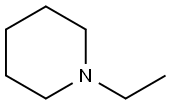CLEAR COLOURLESS TO SLIGHTLY YELLOWISH LIQUID
Reactant for: Synthesis of multiprotected kanosamine1 Selective acylation in peptide synthesis2Reagent for: Stereoselective aldol condensation reactions for synthesis of β-lactam antibiotics3 Diastereoselective synthesis of aldols4 Crossed Claisen ester condensation5
In Room temperature phosphorescence of α-bromonaphthalene induced by cyclodextrin in the presence of hexahydropyridine or 1-ethylpiperidine and its application is described. The highest yields of 5-Bromopyrimidine (37%) were obtained by using 1-ethylpiperidine or triethylamine as condensing agent. Tributyltin hydride and 1-ethylpiperidine hypophosphite were mediated intermolecular radical additions to 2, 4, 6-trichlorophenyl vinyl sulfonate.
ChEBI: N-ethylpiperidine is a member of piperidines.
Organic Syntheses, Coll. Vol. 5, p. 575, 1973
The Journal of Organic Chemistry, 28, p. 3259, 1963
DOI: 10.1021/jo01046a537
A colorless liquid with the odor of pepper. Less dense than water. Flash point 66°F. May irritate skin and eyes. Vapors heavier than air. Used as a solvent and to make other chemicals.
Highly flammable. Soluble in water.
1-Ethylpiperidine neutralizes acids in exothermic reactions to form salts plus water. May be incompatible with isocyanates, halogenated organics, peroxides, phenols (acidic), epoxides, anhydrides, and acid halides. Flammable gaseous hydrogen may be generated in combination with strong reducing agents, such as hydrides.
May cause toxic effects if inhaled or ingested/swallowed. Contact with substance may cause severe burns to skin and eyes. Fire will produce irritating, corrosive and/or toxic gases. Vapors may cause dizziness or suffocation. Runoff from fire control or dilution water may cause pollution.
Flammable/combustible material. May be ignited by heat, sparks or flames. Vapors may form explosive mixtures with air. Vapors may travel to source of ignition and flash back. Most vapors are heavier than air. They will spread along ground and collect in low or confined areas (sewers, basements, tanks). Vapor explosion hazard indoors, outdoors or in sewers. Runoff to sewer may create fire or explosion hazard. Containers may explode when heated. Many liquids are lighter than water.
Flammability and Explosibility
Highly flammable
Poison by intravenous
and subcutaneous routes. An eye irritant. A
very dangerous fire hazard when exposed to
heat or flame; can react vigorously with
oxidizing materials. When heated to
decomposition it emits toxic fumes of Nox.

